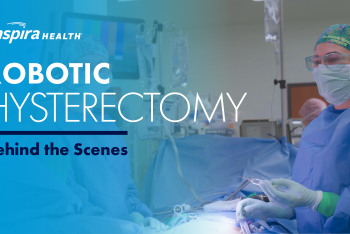Amanda Mirmanesh, D.O., is an OB/GYN at Inspira Medical Center Vineland. Follow her as she arrives...
Read More
When a surgeon describes to you a procedure that can be done with “robotic-precision,” they may mean it quite literally. Skilled surgeons trained in robotic-assisted surgery are able to offer patients a more predictable surgical experience thanks to some incredible robotic systems that have entered the operating room.
Inspira Medical Centers Vineland and Woodbury are home to the da Vinci® Surgical System and Mako™ Robotic-Arm Assisted Technology. Benefits of either system may include a shorter hospital stay, less blood loss, fewer complications, and less need for narcotic pain medicine.
If the thought of robots triggers some kind of sci-fi conspiracy theory for you, fret not. During a robotic surgery, your surgeon has full control over the robot. Robotic surgical arms act as an extension of your surgeon’s hands. The instruments and views provided by the technology allows for a more precise operating experience.
Meet the da Vinci® Surgical System

The Da Vinci® Surgical System is used by urologist, colorectal surgeons, general surgeons, gynecologist and other specialties to perform minimally invasive surgical procedures such as cholecystectomies, or gallbladder removal, hysterectomies, or removal of the uterus. It is also used during prostatectomies, or surgical removal of the prostate and in partial/radical nephrectomies were a portion of, or all of, a kidney is removed.
Procedures performed using the Da Vinci® Surgical System are done using small instruments and a High definition camera passed through several small incisions in the abdomen.
the Da Vinci® Surgical System gives the surgeon a magnified 3D, high-definition view to operate with enhanced vision and precision. The robotic technology allows the surgeon’s hand movements to be translated into smaller, precise movements of tiny instruments used to perform surgery within a tight space.
Smaller surgical incisions reduce the amount of pain experienced by patients after surgery compared with open surgery, reduces recovery time and leaves patients with little to no scarring.
Some robotic procedures can be performed using the single site Da Vinci® System and Inspira was one of the first hospitals in the region to offer patients single-site robotic surgery.
A little about Mako™
Not all orthopedic injuries and conditions require surgery, but Mako™-Robotic Arm Assisted Technology is ready for the ones that do. Mako™ has transformed joint replacement

surgeries into minimally invasive procedures that can be delivered with pinpoint accuracy. Mako™ helps in both total and partial knee replacement procedures, as well as total hip replacements.
Mako™ helps provide a personalized surgical experience for patients. A CT scan prior to surgery will be taken to produce a 3D model of your joint. From that model, your surgeon will develop a personalized surgical plan that gets programmed into the robotic software. During surgery, your surgeon will use a robotic arm to help execute your personalized surgical plan. Using robotic software is like giving surgeons a GPS that acts as a roadmap, guiding them in real-time during surgery. It’s completely personalized to your specific diagnosis and anatomy. Mako™ has the potential to increase the longevity of your joint replacement and decrease your recovery time.

Amanda Mirmanesh, D.O., is an OB/GYN at Inspira Medical Center Vineland. Follow her as she arrives...
Read More
Preparing for surgery can feel overwhelming, but there are ways to minimize your anxiety and focus...
Read More
Treating cancer requires an arsenal of tools and preventive measures. Explore the power of...
Read More
The material set forth in this site in no way seeks to diagnose or treat illness or to serve as a substitute for professional medical care. Please speak with your health care provider if you have a health concern or if you are considering adopting any exercise program or dietary guidelines. For permission to reprint any portion of this website or to be removed from a notification list, please contact us at (856) 537-6772